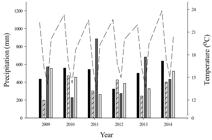ABSTRACT:
The identification of compounds with allelopathic potential produced by cover crops can assist in selecting species for weed management purposes in no-tillage systems. This study aimed to identify the main phenolic compounds with allelopathic potential in the shoot of rye (Secale cereale L.) and oilseed radish (Raphanus sativus L.) cover crops, as well as evaluate whether the cultivation system and phenological stage may influence secondary metabolite production and weed emergence. Samples of the shoot of these cover crops were collected at 60, 80, and 100 days after sowing (DAS) and 15 and 30 days after lodging (DAL) under field conditions. Weed emergence was evaluated at 45, 75, and 100 DAL of cover crops. The main compounds in rye were 6-methoxy-2-benzoxazolinone (MBOA) and 2-benzoxazolinone (BOA) under monocropping and intercropping, while flavonoid quercetin was found in oilseed radish at all evaluated times. During the growing cycle, the highest contents of phenolic compounds were found at the elongation stage (60 DAS) of rye under monocropping and intercropping systems (9.33 and 8.22 mg g-1 DM, respectively) and at grain filling stage (100 DAS) for oilseed radish intercropped with rye and black oat (3.24 and 3.83 mg g-1 DM, respectively). No differences were found in the contents of the main compounds when the species was grown under monocropping or intercropping systems. A reduction in the contents of MBOA, BOA, and quercetin was observed after lodging. Weed dry matter production was lower at 45 DAL in all treatments with rye and oilseed radish residues when compared to the control. The intercropping of rye with oilseed radish is an alternative management for weed control in agroecological systems due to the physical barrier created by these species and the presence of phenolic compounds with allelopathic potential.
Keywords:
cover crops; allelopathy; quercetin; BOA; MBOA

 Thumbnail
Thumbnail
